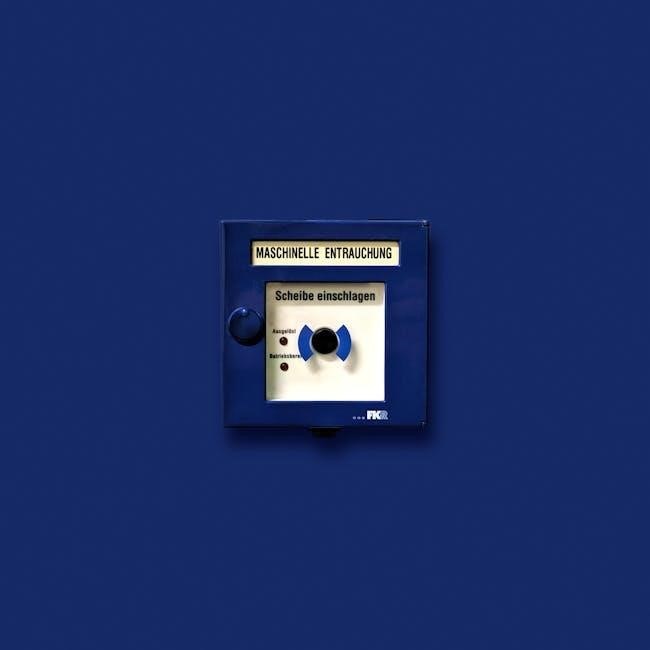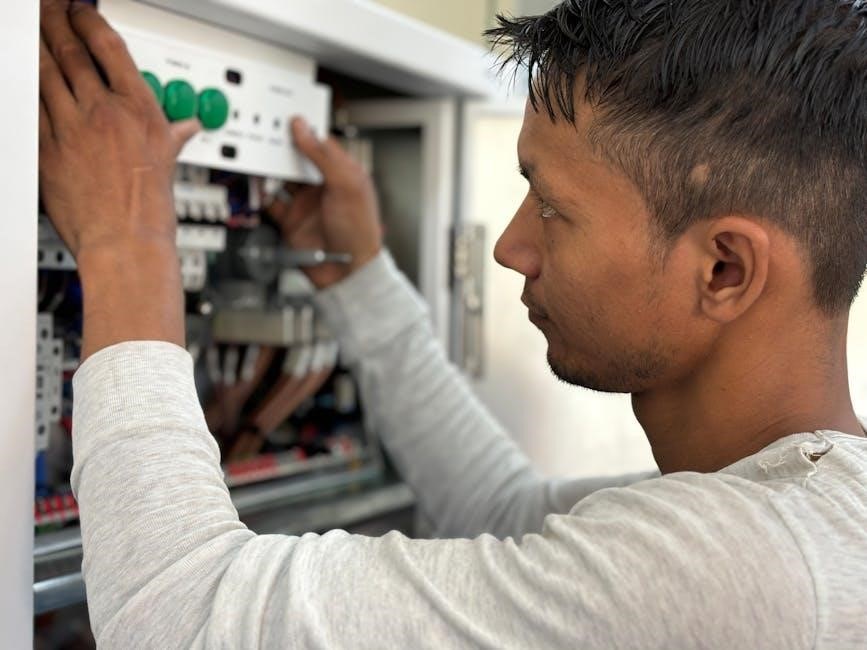The safety neutral switch, also known as the clutch safety switch, ensures the engine starts only when the clutch pedal is fully depressed, preventing accidental vehicle movement.
Overview of the Safety Neutral Switch
The safety neutral switch is a critical component in both manual and automatic transmissions, ensuring the engine starts only when the vehicle is in a safe state. In manual transmissions, it prevents starting unless the clutch pedal is fully depressed, while in automatics, it requires the transmission to be in Park or Neutral. This mechanism enhances safety by preventing accidental vehicle movement, providing drivers with precise control during startups. Modern vehicles integrate this switch with advanced systems, such as remote starters and automated manuals, to maintain reliability and security.
Importance of the Safety Neutral Switch in Manual Transmissions
The safety neutral switch is vital for preventing accidental starts when the transmission is in gear, ensuring the engine only starts when the vehicle is in a safe state. This feature protects drivers from unintended vehicle movement, enhancing overall safety and control. It also integrates with modern systems like remote starters and automated manuals, maintaining security and reliability in various driving scenarios.

Components of the Safety Neutral Switch System
The system includes electrical connectors, wiring, mechanical linkages, and sensors, working together to monitor transmission state and ensure safe engine operation.
Electrical Connectors and Wiring
Electrical connectors and wiring are crucial for transmitting signals from the safety neutral switch to the vehicle’s powertrain control module (PCM). These components ensure proper communication between the switch and the engine control systems. Faulty wiring or corroded connectors can disrupt the signal, leading to issues like engine stalling or failure to start. Regular inspection and maintenance are essential to prevent such problems.
Mechanical Linkage and Sensors
Mechanical linkages connect the safety neutral switch to the transmission, ensuring accurate gear position detection. Sensors within the system monitor the clutch pedal’s position and transmission gear engagement, providing real-time data to the PCM. Proper alignment and adjustment of these components are vital for reliable operation and driver safety, preventing unintended engine starts when the vehicle is in gear.

Functionality of the Safety Neutral Switch
The safety neutral switch prevents engine start when the transmission is in gear, enabling ignition only when the clutch pedal is fully depressed, enhancing safety and control.
Engagement and Disengagement Mechanism
The safety neutral switch engages when the clutch pedal is pressed, allowing the starter to function. It disengages when the pedal is released, preventing accidental starts. The mechanism relies on a mechanical linkage connected to the clutch pedal, ensuring the switch activates only when the pedal is fully depressed. This prevents the engine from starting in gear, enhancing safety and control during vehicle operation.
Role of the Powertrain Control Module (PCM)
The Powertrain Control Module (PCM) monitors the safety neutral switch’s signals to determine the transmission’s gear state. If the switch indicates the vehicle is not in neutral, the PCM prevents the engine from starting. This electronic oversight ensures the vehicle cannot start accidentally while in gear, adding a critical layer of safety and control to the manual transmission system.
Installation and Adjustment of the Safety Neutral Switch
Installation involves mounting the switch, connecting wiring, and ensuring proper alignment with the transmission. Adjustment requires calibrating the switch to accurately detect neutral gear position for reliable operation.
Step-by-Step Installation Guide
Locate the transmission’s neutral position and mount the switch securely. Connect the wiring harness to the switch, ensuring proper alignment with the transmission’s neutral sensor. Tighten the mounting bolts and verify the switch’s electrical connections. Test the switch by shifting through gears to ensure it accurately detects neutral position. Refer to the vehicle’s wiring diagram for specific connector locations and configurations. Finally, test the engine start functionality to confirm proper installation and operation.
Adjustment and Calibration Techniques
Adjust the neutral switch by loosening the mounting bolts and shifting the switch until it aligns with the transmission’s neutral position. Tighten the bolts and test by starting the engine in neutral and each gear to ensure the switch prevents starting in gear. Use a multimeter to verify electrical continuity in neutral and open circuits in other gears. Repeat adjustments as needed for precise operation and reliability.
Troubleshooting Common Issues
Common issues include failure to start in neutral or unintended gear engagement. Check switch alignment, wiring connections, and clutch pedal linkage for proper function and wear.
Diagnosing Faults in the Safety Neutral Switch
Diagnosing faults involves testing the switch with a multimeter for continuity and proper electrical connections. Check wiring for damage or corrosion and ensure the switch is aligned correctly. Symptoms like failure to start in neutral or intermittent issues indicate a potential malfunction. Inspect the clutch pedal linkage for smooth operation and verify the PCM communication for accurate gear position signals.
Repair and Replacement Procedures
Replacement involves disconnecting electrical connectors and removing the switch from the transmission or clutch pedal. Inspect and clean the area before installing a new switch, ensuring proper alignment and secure mounting. Test the system by starting the engine in neutral and checking for correct functionality. If damaged, wiring and connectors should be repaired or replaced to maintain system integrity and safety.
Safety Benefits of the Neutral Safety Switch
The neutral safety switch prevents accidental starts and ensures the engine only engages in neutral, protecting the transmission and enhancing overall vehicle safety.
Prevention of Accidental Starts
The neutral safety switch prevents accidental vehicle movement by ensuring the engine cannot start unless the transmission is in neutral and the clutch pedal is fully depressed. This feature is crucial, as it avoids unintended starts when the car is in gear, reducing the risk of accidents, especially on inclines or when the driver inadvertently engages the ignition.
Enhanced Driver Control and Transmission Protection
The neutral safety switch enhances driver control by ensuring the vehicle starts only when proper conditions are met, such as the clutch pedal being fully depressed. This prevents premature wear on the transmission and clutch system, protecting components from unnecessary stress and prolonging their lifespan while maintaining smooth operation and reliability over time.

Applications in Different Vehicle Models
The safety neutral switch is widely used in manual transmissions of BMW, Mazda, Ford, and other manufacturers, ensuring reliable starting conditions across various vehicle models and aftermarket solutions.
BMW, Mazda, and Ford Applications
BMW, Mazda, and Ford utilize the safety neutral switch in their manual transmissions to ensure safe starting conditions. BMW integrates it with advanced systems, while Mazda incorporates it into durable designs. Ford employs it for seamless functionality. These applications highlight the switch’s versatility and reliability across different vehicle models, ensuring driver safety and transmission protection. This technology is consistent across various makes.
Aftermarket and OEM Solutions
Aftermarket and OEM solutions for the safety neutral switch are widely available, offering reliable operation and proven durability. Trusted suppliers provide high-quality parts designed to meet or exceed original specifications. These solutions ensure seamless integration with manual transmissions, maintaining safety and functionality. Aftermarket options often provide cost-effective alternatives, while OEM parts guarantee precise compatibility and performance, making them ideal for various vehicle models.

Comparison with Automatic Transmission Neutral Safety Switch
Both manual and automatic transmissions use neutral safety switches to prevent accidental starts. However, manual systems rely on the clutch pedal, while automatics depend on gear position.
Similarities and Differences
Both manual and automatic neutral safety switches prevent accidental starts, but they differ in operation. Manual systems rely on the clutch pedal, while automatics depend on gear position. Automatic switches deactivate in park or neutral, whereas manual switches require full clutch depression. These differences reflect distinct transmission mechanisms but share the same safety goal. Both ensure the engine starts safely, enhancing overall vehicle control and protection.
Automatic vs. Manual Transmission Safety Features
Automatic transmissions use a neutral safety switch to prevent starting in gear, requiring the shifter to be in park or neutral. Manual transmissions rely on a clutch safety switch, which only allows starting when the clutch pedal is fully depressed. Both systems aim to prevent accidental starts but differ in operation, with automatics focusing on gear position and manuals on clutch engagement.

Advanced Features and Modern Developments
Modern systems like Auto Neutral and Rolling Start enhance safety and efficiency in manual transmissions, allowing seamless gear transitions and improved control during operation.
Auto Neutral and Rolling Start Technologies
Introducing advanced features like Auto Neutral and Rolling Start technologies, modern manual transmissions enhance safety and efficiency. These systems automatically shift to neutral, allowing smooth starts without manual intervention.
Mack Trucks pioneered these innovations, integrating them into their mDrive and mDrive HD transmissions. They improve paving performance and reduce accidents by ensuring proper gear control during operation, particularly beneficial in heavy-duty applications, enhancing driver control.
Integration with Automated Manual Transmissions
Modern automated manual transmissions integrate the safety neutral switch seamlessly, enhancing functionality. Volvo and Mack Trucks incorporate Auto Neutral and Rolling Start technologies, ensuring smooth operation. These systems automatically shift to neutral for safer starts and improved control, especially in heavy-duty applications; This integration reduces driver fatigue and enhances performance, making it ideal for advanced transmission systems in vehicles like the Volvo I-Shift and Mack mDrive.

Maintenance and Care Tips
Regularly clean the safety neutral switch to prevent dirt buildup. Inspect electrical connectors for damage and ensure secure connections. Perform routine checks to maintain proper functionality and safety standards;
Cleaning and Inspecting the Switch
Start by disconnecting the battery to ensure safety. Use compressed air or a soft brush to remove dirt from the switch and connectors. Inspect for wear, corrosion, or loose connections. Clean electrical contacts with a mild solvent and dry thoroughly. Check the mechanical linkage for smooth operation and proper alignment. Replace any damaged components immediately to maintain functionality.
Regular Maintenance Schedule
Inspect the safety neutral switch every 12,000 to 15,000 miles. Check electrical connectors for corrosion and ensure secure connections. Lubricate mechanical linkages if necessary. Verify proper alignment and operation of the switch. Replace worn or damaged components promptly. Consult your vehicle’s service manual for specific intervals and procedures. Regular maintenance ensures reliable performance and prevents unexpected failures.
The safety neutral switch is a vital component in manual transmissions, ensuring safe engine starts and preventing accidental movement. Regular maintenance is essential for optimal functionality and reliability.
The safety neutral switch, also known as the clutch safety switch, is essential in manual transmissions to prevent accidental starts. It ensures the engine only starts when the clutch pedal is fully depressed, enhancing safety and control. Proper installation, adjustment, and maintenance are crucial for reliable operation. This switch is vital for preventing unintended vehicle movement and protecting the transmission.
Final Thoughts on the Importance of the Safety Neutral Switch
The safety neutral switch is a critical component in manual transmissions, ensuring vehicle safety by preventing accidental starts and protecting the driver. Its role in maintaining control and preventing unintended movement cannot be overstated. Regular maintenance and proper installation are essential to uphold its functionality. This switch remains a vital feature for enhancing driver safety and transmission longevity in modern vehicles.



